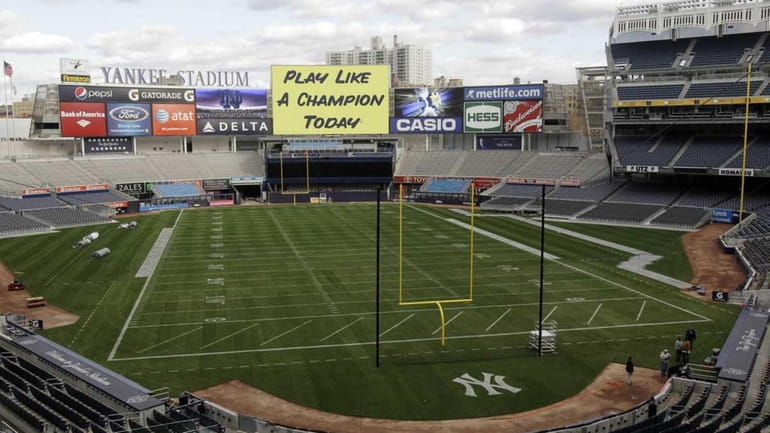Yankees transform stadium for Notre Dame-Army game

A look at Yankee Stadium in the process of being converted to a football stadium for the Notre Dame-Army game. (Nov. 17, 2010) Credit: AP
A 25-page, single-spaced manifesto serves as a blueprint of sorts, detailing every expectation and each responsibility for a staff of hundreds.
The members of the Yankees organization, from the grounds crew to the security staff to front-office personnel, have all played an integral role in transforming Yankee Stadium into a venue suited for college football - and one of its most historic rivalries.
When Notre Dame hosts Army at 7:30 p.m. Saturday, it will mark the 50th meeting between the universities and the first football game to be played at the new Yankee Stadium.
And that manifesto, said Yankees chief operating officer Lonn Trost, details "how we're doing what we're doing."
The initial modifications began during the All-Star break when the foundation for the goalposts was laid in centerfield. But the alterations kicked into high gear when the Yankees' postseason run ended in late October. Removing the pitcher's mound and laying sod in the infield came next.
"Those were the only things we needed to do. Everything else we did, we chose to do," said Trost, who added that the organization installed temporary bleachers in the corners of leftfield and rightfield and in the dugout due to high ticket demand. One goalpost was erected in front of home plate and the other is in centerfield. The yard markers were painted last week.
Notre Dame coach Brian Kelly said this week that safety was a key issue. To ensure the field met both universities' respective standards, his director of football operations, Chad Klunder, traveled to New York a few times to inspect the site.
"His reports have been positive," Kelly said. "But it's clearly something that has been at the forefront of every conversation that I've heard of, from moving a foul pole to making sure there's enough access on the sidelines. We're going to go over the logistics on Friday more in detail than probably we have ever at a venue."
The challenge for the Yankees, however, is not only physical. "It's about rethinking what we're doing," Trost said. "The sidelines change, even the 'How may we help you?' people have to change the way they think."
But meeting the demands of outside teams isn't a unique experience for the Yankees.
"We coordinate with our home team and road teams," said Trost, who also said there will be three ambulances (two more than usual) on site as well as a full X-ray room. "We knew what their demands were, their needs were. When the stadium was built we had this in mind."
Football was rooted in the fabric of the old Yankee Stadium, which hosted countless collegiate games - the first Army-Notre Dame game was a 27-0 victory for Army on Oct. 25, 1925 - before its closure in 2008. And the plan all along was to bring college football back to the Bronx, Trost said.
After a 23-year absence, tomorrow's game will be the first of two contests this year. The second is the Pinstripe Bowl, to be held annually beginning Dec. 17. And more games are on the horizon. Last summer the Yankees announced the Stadium will host a series of Army home football games (vs. Rutgers in 2011, Air Force in 2012 and Boston College in 2014). They're also in talks with the University of Miami about hosting the Hurricanes.
